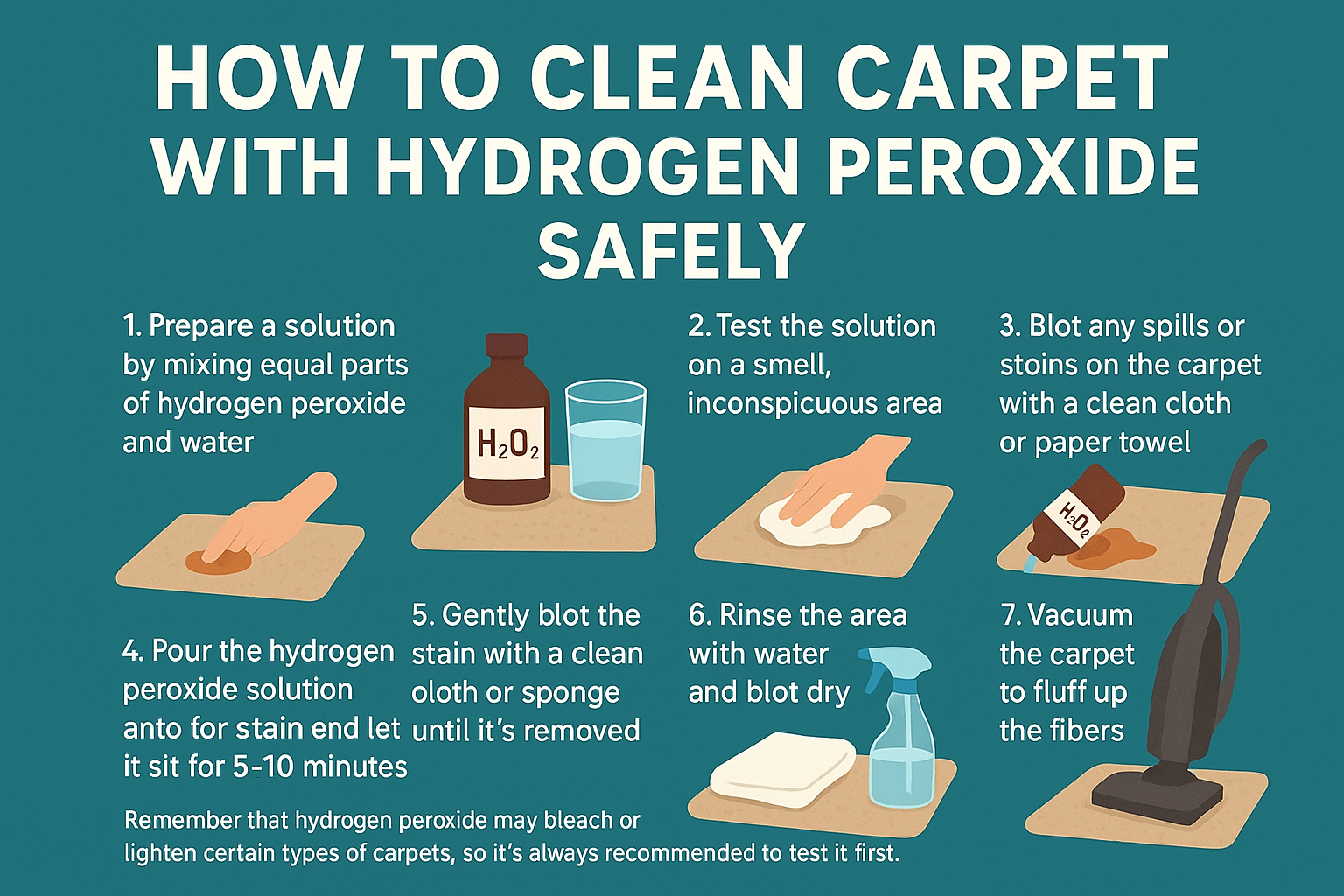Hydrogen peroxide (3%) is a budget-friendly oxidizer that breaks down organic stains fast. Used correctly, it can lift blood, wine, coffee, and pet accidents while neutralizing odors. Below is a safe, color-conscious method, plus targeted tweaks by stain type.
Important: Always test in a hidden spot for colorfastness. Do not use on wool, silk, or plant-dyed carpets. Never mix peroxide with vinegar or other acids in the same container.
Quick Start: The Safe 7-Step Peroxide Method
- Vacuum and prep. Remove dry soil so chemistry can reach the stain.
- Blot, don’t rub. Lift fresh spill with plain white towels.
- Test. In a closet corner, spray 3% hydrogen peroxide; blot after 5 minutes. Proceed only if no color transfer or lightening.
- Mix. Add 1 part 3% hydrogen peroxide to 1 part water in a spray bottle for general use. For whites/light beiges, you may use 3% straight after testing.
- Apply. Lightly mist the stain until damp (not soaked). Wait 10–15 minutes.
- Blot and lift. Press with fresh towels, working outside-in. Repeat light mist + blot cycle as needed.
- Rinse and dry. Mist with clean water, blot dry, then speed-dry with a fan. Finish with a slow vacuum pass to groom fibers.
Targeted Stain Playbook
Use these tweaks on top of the 7-step method to match stain chemistry.
Blood (fresh or dried)
- Pre-treat with cold water blotting (heat sets proteins).
- Apply 3% hydrogen peroxide directly; foam is normal as oxygen releases.
- Blot, then rinse with cold water and blot dry.
Pet Urine (odor and yellowing)
- Blot thoroughly. If old, lightly mist with water to rehydrate before blotting.
- Apply diluted peroxide (1:1 with water). Wait 10–15 minutes.
- Blot. If odor lingers, follow with an enzyme cleaner per label, then rinse and dry.
Red Wine, Juice, Coffee, Tea
- Blot up excess. For coffee/tea, a drop of clear dish soap in water helps.
- Mist peroxide solution; dwell 10–15 minutes.
- Blot; repeat if needed. Rinse with water and blot dry.
What Not To Do
- Do not oversaturate the pad—wick-back and browning can occur.
- Do not use on wool, silk, viscose/rayon, or plant-dyed fibers.
- Do not mix peroxide with vinegar or other acids in the same bottle (this creates peracetic acid, an irritant).
- Avoid high concentrations (>3%) on residential carpet.
Hydrogen Peroxide vs Other Methods
Peroxide excels on organic stains (blood, wine, food, pet accidents). For broad deep cleaning, hot water extraction or low-moisture methods may be better. See our comparison guide below.
Steam Clean vs Shampoo: Which Is Better? • How To Clean Carpet Like The Pros • Common Carpet Stains: Removal Tips
FAQ
Will hydrogen peroxide bleach my carpet?
On many synthetic, colorfast carpets, 3% is safe when tested first. It may lighten some dyes and is not recommended for wool, silk, or viscose.
How long should I let it sit?
10–15 minutes per cycle. Reapply in light passes rather than one heavy soak.
Is it good for odors?
Yes for many organic odors. For pet urine that penetrated the pad, pair peroxide with an enzyme cleaner and thorough drying.
Can I rent a machine after spot treating?
Yes—rinsing with a water-only extraction pass helps remove residues and prevent re-soiling.
Related Guides
How To Clean Milk Out Of Carpet • How To Clean Cat Poop Out Of Carpet • How To Clean Carpet After Water Damage
Summary
Use 3% hydrogen peroxide in light, tested applications, with patient blotting and a clean-water rinse. Match tweaks to the stain type, avoid sensitive fibers, and keep moisture controlled to prevent wick-back.
Editor’s Note (Safety)
Wear gloves, keep products labeled, and ventilate the room. Store peroxide away from light and heat in its original opaque bottle.
This guide is for general information only. For delicate or valuable rugs, consult a professional.
